Mixing of Particles in a Rotating Drum with Inclined Axis of Rotation
Abstract
1. Introduction
2. Simulation Method and Conditions
2.1. Simulation Method
2.2. Simulation Conditions
2.3. Calculation of Area Ratio and Mixing Index
3. Results and Discussion
3.1. Net Mass Flow Rate
3.2. Volumetric Fill
3.3. Area Ratio
3.4. Mixing Efficiency
4. Conclusions
- In the initial few seconds of the simulations, at each location of the drum, the net mass flow rate towards the lower end of the inclined drum in the axial direction increase to a peak, and then gradually reduces as time progresses. The highest peaks of the net mass flow rate happen at the center location of the drum. Once the steady state is achieved, the mass flow rate fluctuates around zero due to the axial dispersion of particles, similar to the horizontal drum.
- The area ratio has the similar variation to the Lacey mixing index along the length of the drum. For the horizontal rotating drum, both the properties remain almost constant along the length of the drum. When the inclination of the drum increases a bit, they increase along the length of the drum. However, for higher inclination (α = 10° and 15°), the area ratio and Lacey mixing index start with relatively low value near the lower end of the drum, and increase drastically to a peak, and then decreases to a value with the distance to the lower end of the drum. After that, they exhibit an increase trend with the distance. The area ratio and Lacey mixing index are dependent on the volumetric fill. They decrease with the increase in the volumetric fill. It has also been observed that the Lacey mixing index is directly proportional to the area ratio.
- The angle of inclination of the rotating drum considerably impacts the Lacey mixing index. The mixing index increases with the increase in the angle of inclination up to 10°, and then reduces. Compared to the horizontal one, the drum with 10° inclination has 7.2% higher Lacey mixing index, which demonstrates a higher mixing efficiency. This indicates that the mixing efficiency can be enhanced by the optimization of angle of inclination of rotating drums.
Author Contributions
Funding
Acknowledgments
Conflicts of Interest
References
- Ahmadian, H.; Hassanpour, A.; Ghadiri, M. Analysis of granule breakage in a rotary mixing drum: Experimental study and distinct element analysis. Powder Technol. 2011, 210, 175–180. [Google Scholar]
- Escotet-Espinoza, M.S.; Foster, C.J.; Ierapetritou, M. Discrete Element Modeling (DEM) for mixing of cohesive solids in rotating cylinders. Powder Technol. 2018, 335, 124–136. [Google Scholar]
- Golshan, S.; Zarghami, R.; Norouzi, H.R.; Mostoufi, N. Granular mixing in Nauta blenders. Powder Technol. 2017, 305, 279–288. [Google Scholar]
- Jiang, M.; Zhao, Y.; Liu, G.; Zheng, J. Enhancing mixing of particles by baffles in a rotating drum mixer. Particuology 2011, 9, 270–278. [Google Scholar]
- Zhang, Z.; Gui, N.; Ge, L.; Li, Z. Numerical study of mixing of binary-sized particles in rotating tumblers on the effects of end-walls and size ratios. Powder Technol. 2017, 314, 164–174. [Google Scholar]
- Schutyser, M.; Weber, F.; Briels, W.J.; Boom, R.; Rinzema, A. Three dimensional simulation of grain mixing in three different rotating drum designs for solid state fermentation. Biotechnol. Bioeng. 2002, 79, 284–294. [Google Scholar]
- Arntz, M.; den Otter, W.K.; Briels, W.J.; Bussmann, P.; Beeftink, H.; Boom, R. Granular mixing and segregation in a horizontal rotating drum: A simulation study on the impact of rotational speed and fill level. AlChE J. 2008, 54, 3133–3146. [Google Scholar]
- Gui, N.; Yang, X.; Tu, J.; Jiang, S. SIPHPM simulation and analysis of cubic particle mixing patterns and axial dispersion mechanisms in a three-dimensional cylinder. Powder Technol. 2018, 335, 235–249. [Google Scholar]
- Liu, X.; Hu, Z.; Wu, W.; Zhan, J.; Herz, F.; Specht, E. DEM study on the surface mixing and whole mixing of granular materials in rotary drums. Powder Technol. 2017, 315, 438–444. [Google Scholar]
- Liu, P.; Yang, R.; Yu, A. DEM study of the transverse mixing of wet particles in rotating drums. Chem. Eng. Sci. 2013, 86, 99–107. [Google Scholar]
- Yu, F.; Zhang, S.; Zhou, G.; Zhang, Y.; Ge, W. Geometrically exact discrete-element-method (DEM) simulation on the flow and mixing of sphero-cylinders in horizontal drums. Powder Technol. 2018, 336, 415–425. [Google Scholar]
- Abouzeid, A.-Z.M.; Fuerstenau, D.W. Mixing–demixing of particulate solids in rotating drums. Int. J. Miner. Process. 2010, 95, 40–46. [Google Scholar]
- Huang, A.-N.; Kuo, H.-P. Developments in the tools for the investigation of mixing in particulate systems—A review. Adv. Powder Technol. 2014, 25, 163–173. [Google Scholar]
- Chen, H.; Xiao, Y.G.; Liu, Y.L.; Shi, Y.S. Effect of Young’s modulus on DEM results regarding transverse mixing of particles within a rotating drum. Powder Technol. 2017, 318, 507–517. [Google Scholar]
- Gui, N.; Fan, J.; Cen, K. A macroscopic and microscopic study of particle mixing in a rotating tumbler. Chem. Eng. Sci. 2010, 65, 3034–3041. [Google Scholar]
- Gui, N.; Yang, X.; Tu, J.; Jiang, S.; Zhang, Z. Numerical simulation of tetrahedral particle mixing and motion in rotating drums. Particuology 2018, 39, 1–11. [Google Scholar]
- Yamamoto, M.; Ishihara, S.; Kano, J. Evaluation of particle density effect for mixing behavior in a rotating drum mixer by DEM simulation. Adv. Powder Technol. 2016, 27, 864–870. [Google Scholar]
- Soni, R.K.; Mohanty, R.; Mohanty, S.; Mishra, B. Numerical analysis of mixing of particles in drum mixers using DEM. Adv. Powder Technol. 2016, 27, 531–540. [Google Scholar]
- Fan, L. Bulk-solids mixing: Overview. In Handbook of Conveying and Handling of Particulate Solids; Levy, A., Kalman, H., Eds.; Elsevier: Amsterdam, The Netherlands, 2001; pp. 647–658. [Google Scholar]
- Lacey, P.M.C. Developments in the theory of particle mixing. J. Appl. Chem. 1954, 4, 257–268. [Google Scholar]
- Xu, Y.; Xu, C.; Zhou, Z.; Du, J.; Hu, D. 2D DEM simulation of particle mixing in rotating drum: A parametric study. Particuology 2010, 8, 141–149. [Google Scholar]
- Yu, F.; Zhou, G.; Xu, J.; Ge, W. Enhanced axial mixing of rotating drums with alternately arranged baffles. Powder Technol. 2015, 286, 276–287. [Google Scholar] [CrossRef]
- Mellmann, J. The transverse motion of solids in rotating cylinders–Forms of motion and transition behavior. Powder Technol. 2001, 118, 251–270. [Google Scholar] [CrossRef]
- Alizadeh, E.; Dubé, O.; Bertrand, F.; Chaouki, J. Characterization of mixing and size segregation in a rotating drum by a particle tracking method. AlChE J. 2013, 59, 1894–1905. [Google Scholar] [CrossRef]
- Arntz, M.; Beeftink, H.; den Otter, W.K.; Briels, W.J.; Boom, R. Segregation of granular particles by mass, radius, and density in a horizontal rotating drum. AlChE J. 2014, 60, 50–59. [Google Scholar] [CrossRef]
- Liu, X.; Ma, W.; Hou, Q.; Zhang, Q.; Gong, B.; Feng, Y. End-wall effects on the mixing process of granular assemblies in a short rotating drum. Powder Technol. 2018, 339, 497–505. [Google Scholar] [CrossRef]
- Xiao, X.; Tan, Y.; Zhang, H.; Deng, R.; Jiang, S. Experimental and DEM studies on the particle mixing performance in rotating drums: Effect of area ratio. Powder Technol. 2017, 314, 182–194. [Google Scholar] [CrossRef]
- Rutgers, R. Longitudinal mixing of granular material flowing through a rotating cylinder: Part II. Experimental. Chem. Eng. Sci. 1965, 20, 1089–1100. [Google Scholar] [CrossRef]
- Li, S.-Q.; Yan, J.-H.; Li, R.-D.; Chi, Y.; Cen, K.-F. Axial transport and residence time of MSW in rotary kilns: Part I. Experimental. Powder Technol. 2002, 126, 217–227. [Google Scholar] [CrossRef]
- Njeng, A.B.; Vitu, S.; Clausse, M.; Dirion, J.-L.; Debacq, M. Effect of lifter shape and operating parameters on the flow of materials in a pilot rotary kiln: Part II. Experimental hold-up and mean residence time modeling. Powder Technol. 2015, 269, 566–576. [Google Scholar] [CrossRef]
- Zhu, H.P.; Zhou, Z.Y.; Yang, R.Y.; Yu, A.B. Discrete particle simulation of particulate systems: A review of major applications and findings. Chem. Eng. Sci. 2008, 63, 5728–5770. [Google Scholar] [CrossRef]
- Cundall, P.A.; Strack, O.D.L. A discrete numerical model for granular assemblies. Geotechnique 1979, 29, 47–65. [Google Scholar] [CrossRef]
- Zhu, H.P.; Zhou, Z.Y.; Yang, R.Y.; Yu, A.B. Discrete particle simulation of particulate systems: Theoretical developments. Chem. Eng. Sci. 2007, 62, 3378–3396. [Google Scholar] [CrossRef]
- Elskamp, F.; Kruggel-Emden, H.; Hennig, M.; Teipel, U. A strategy to determine DEM parameters for spherical and non-spherical particles. Granul. Matter 2017, 19, 46. [Google Scholar] [CrossRef]
- Yang, S.; Sun, Y.; Zhang, L.; Chew, J.W. Segregation dynamics of a binary-size mixture in a three-dimensional rotating drum. Chem. Eng. Sci. 2017, 172, 652–666. [Google Scholar] [CrossRef]
- Chen, H.; Zhao, X.; Xiao, Y.; Liu, Y.; Liu, Y. Radial mixing and segregation of granular bed bi-dispersed both in particle size and density within horizontal rotating drum. Trans. Nonferrous Met. Soc. China 2016, 26, 527–535. [Google Scholar] [CrossRef]
- Basinskas, G.; Sakai, M. Numerical study of the mixing efficiency of a ribbon mixer using the discrete element method. Powder Technol. 2016, 287, 380–394. [Google Scholar] [CrossRef]
- Kawaguchi, T.; Tsutsumi, K.; Tsuji, Y. MRI measurement of granular motion in a rotating drum. Part. Part. Syst. Charact. 2006, 23, 266–271. [Google Scholar] [CrossRef]
- Ding, Y.; Forster, R.; Seville, J.; Parker, D. Segregation of granular flow in the transverse plane of a rolling mode rotating drum. Int. J. Multiph. Flow 2002, 28, 635–663. [Google Scholar] [CrossRef]

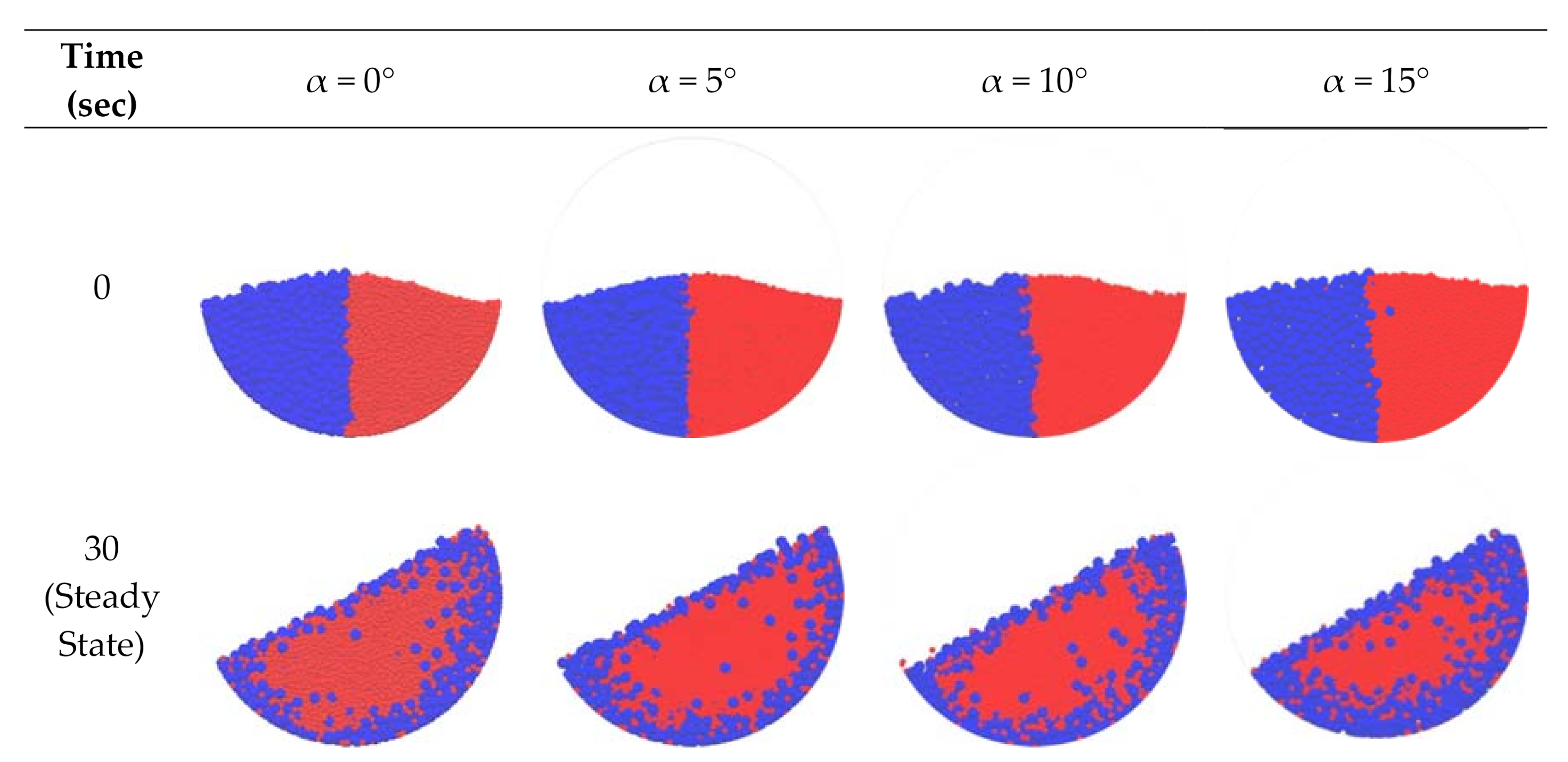
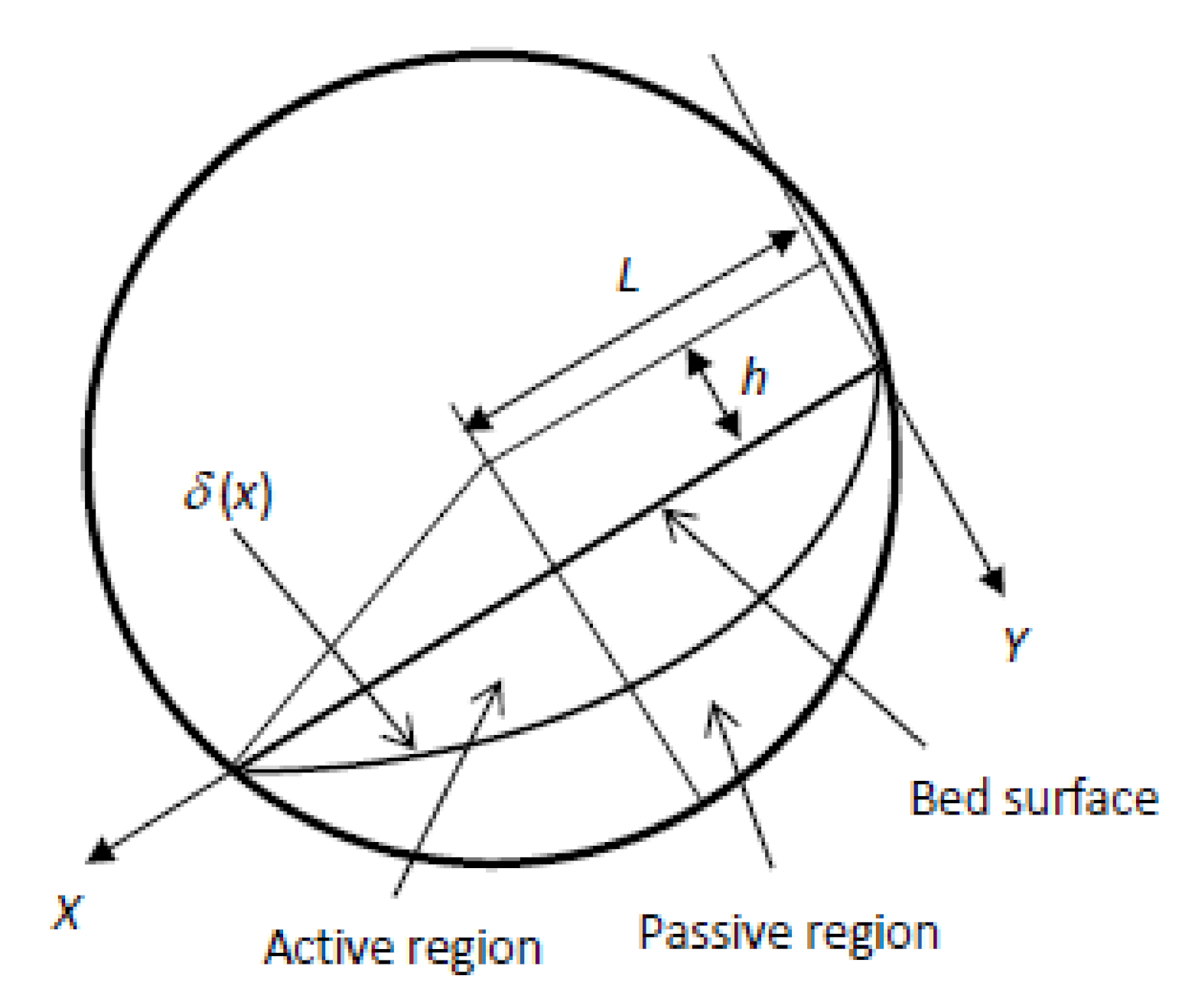
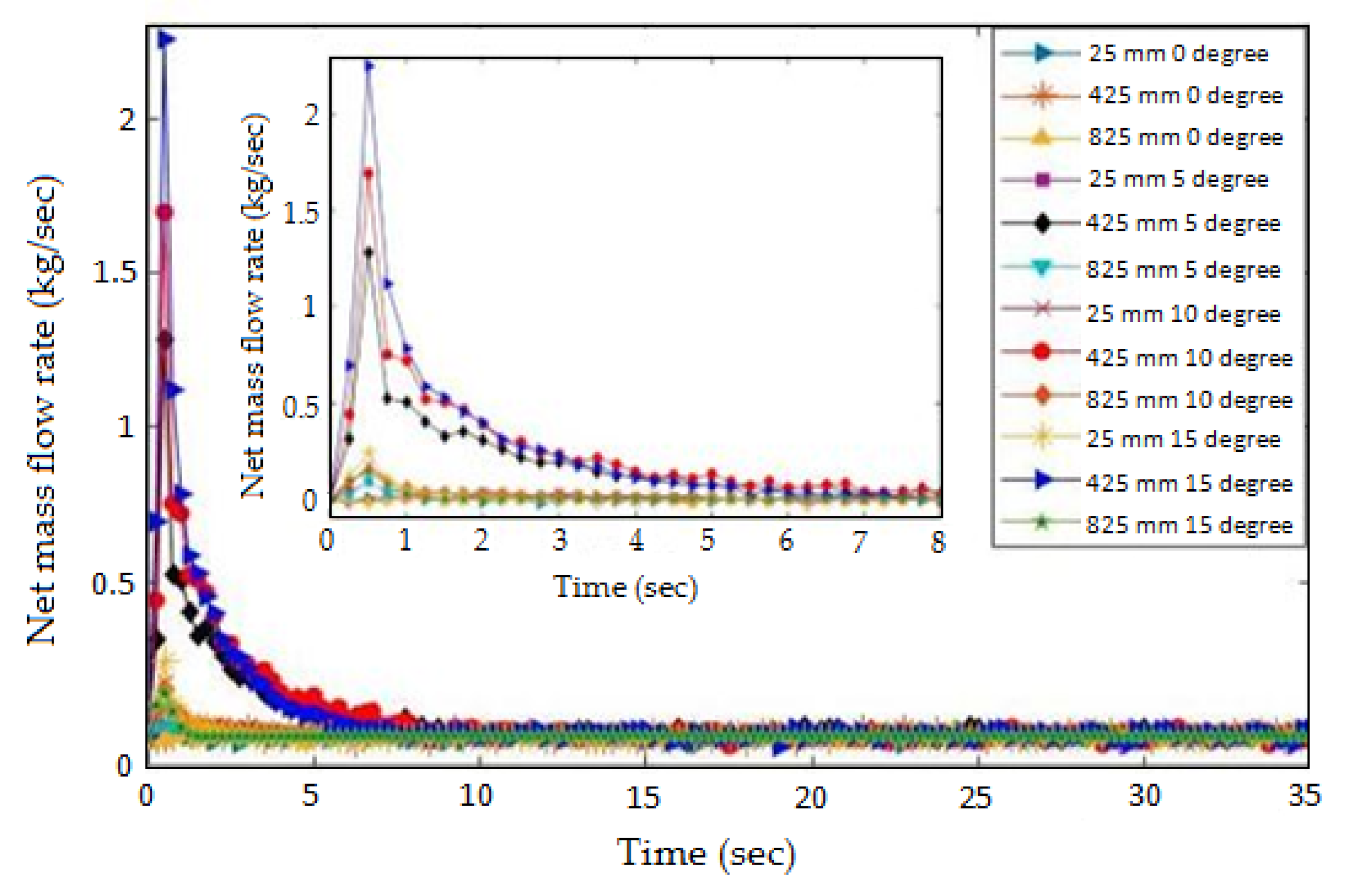
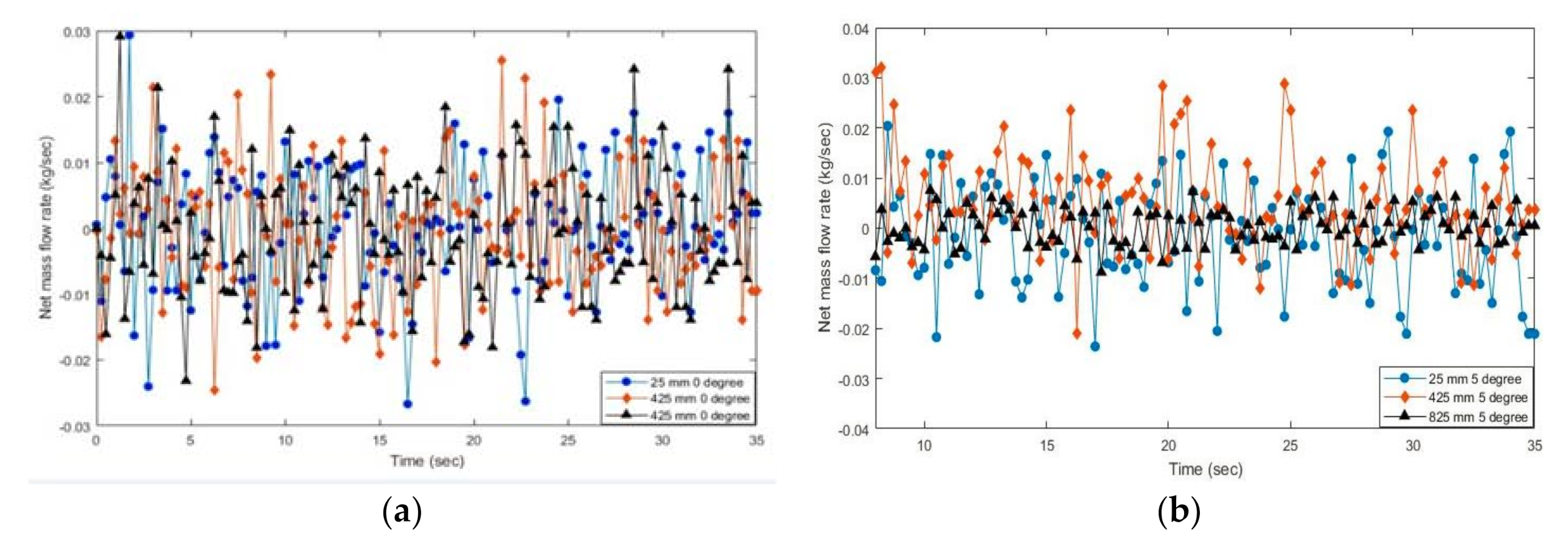

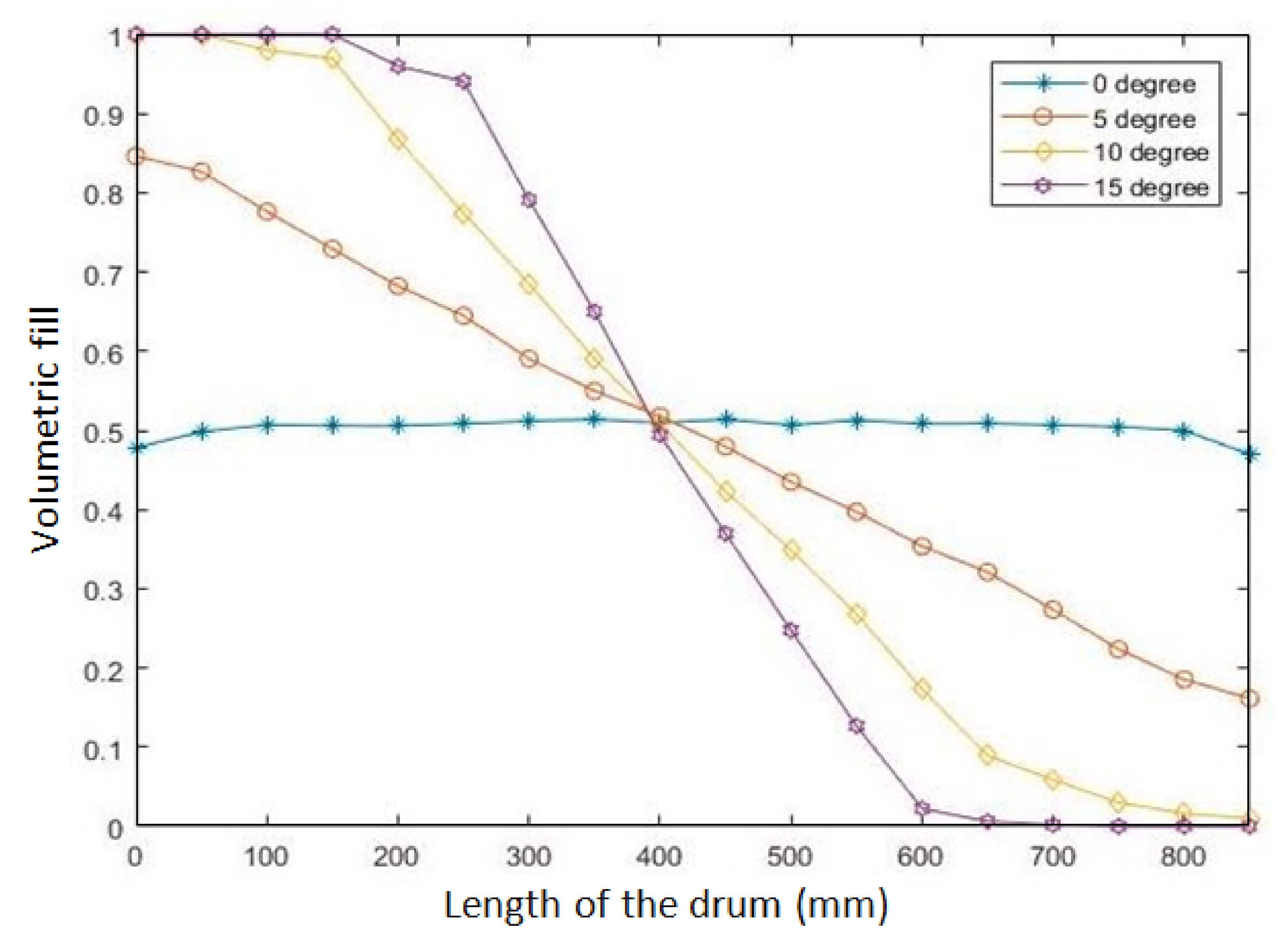

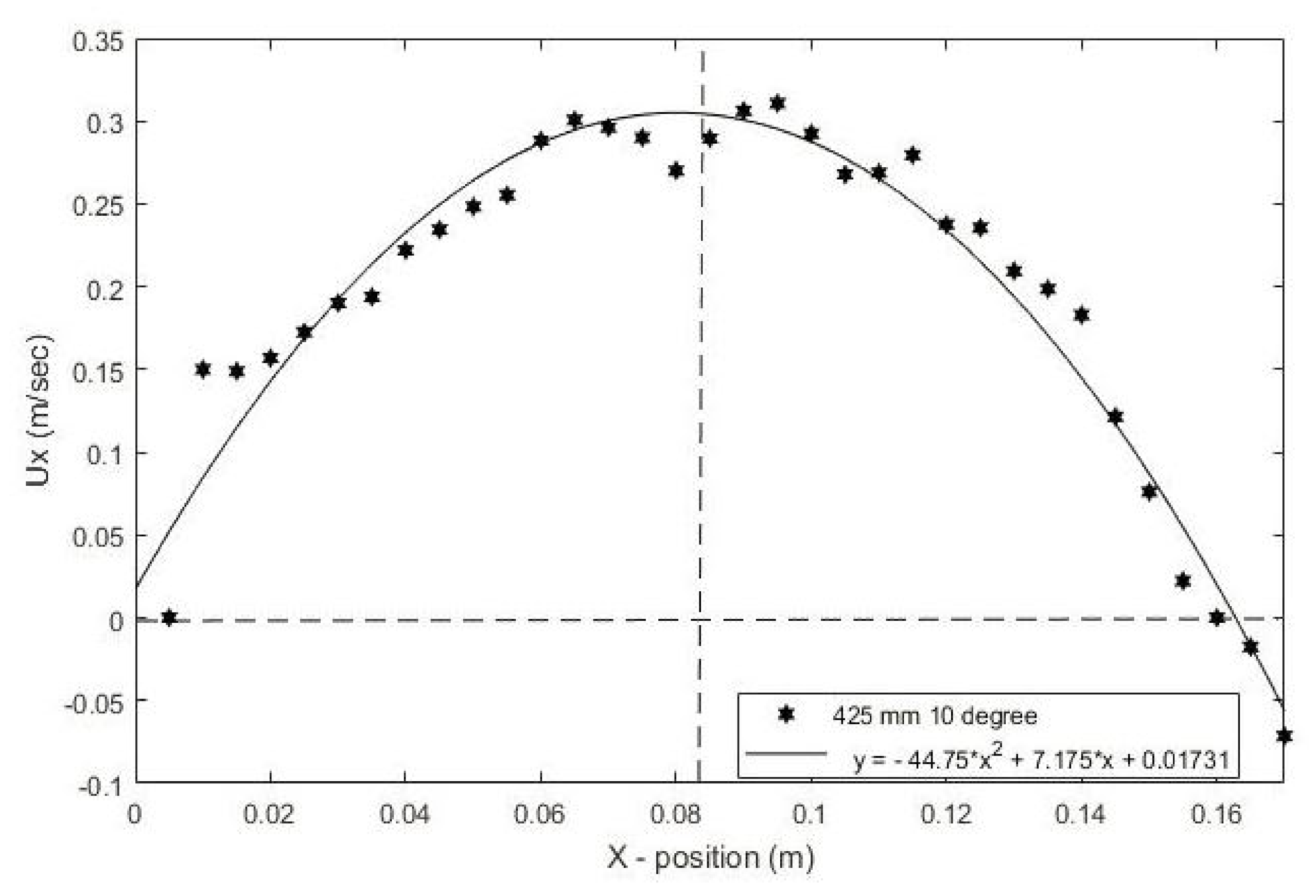

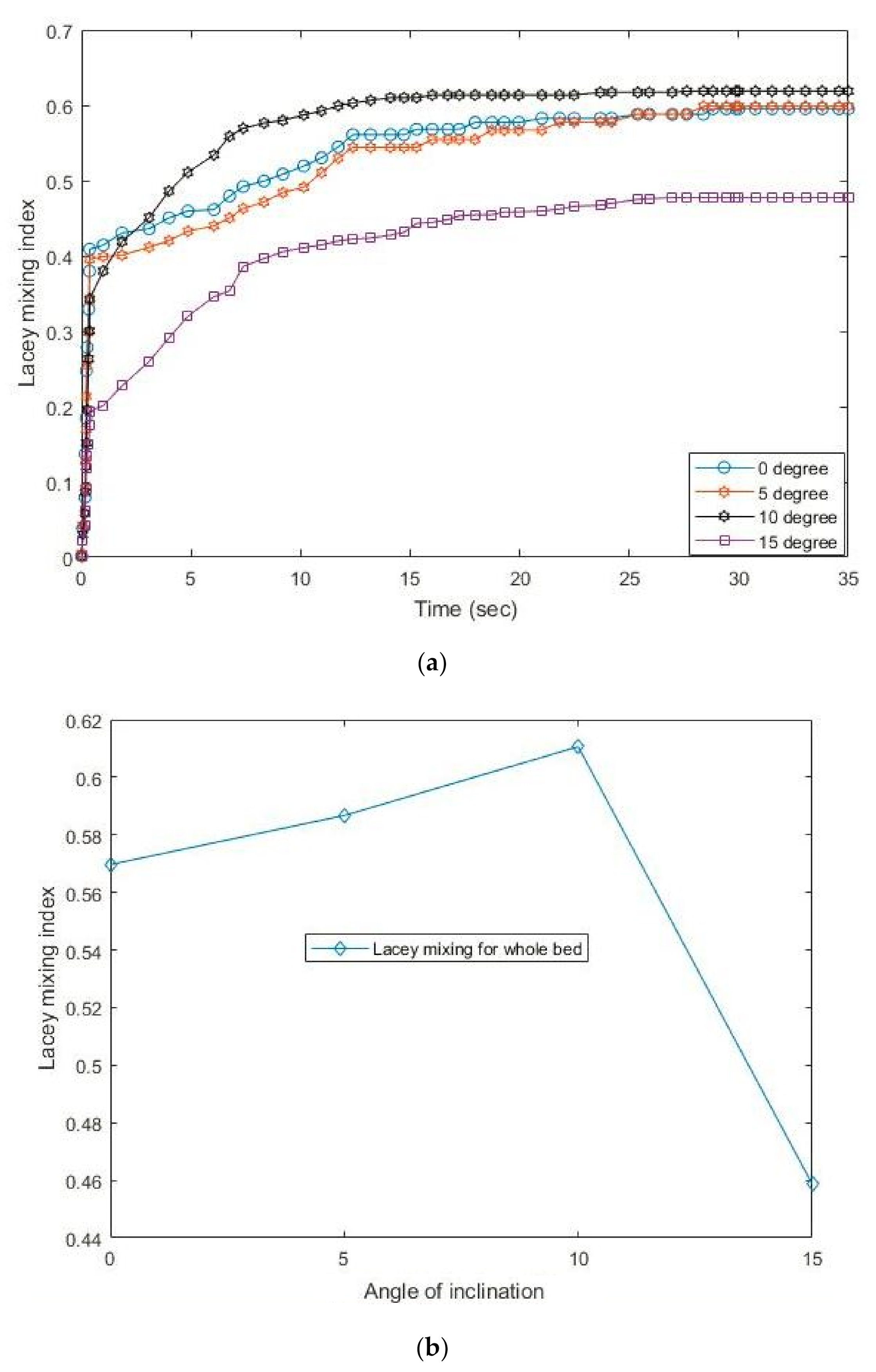

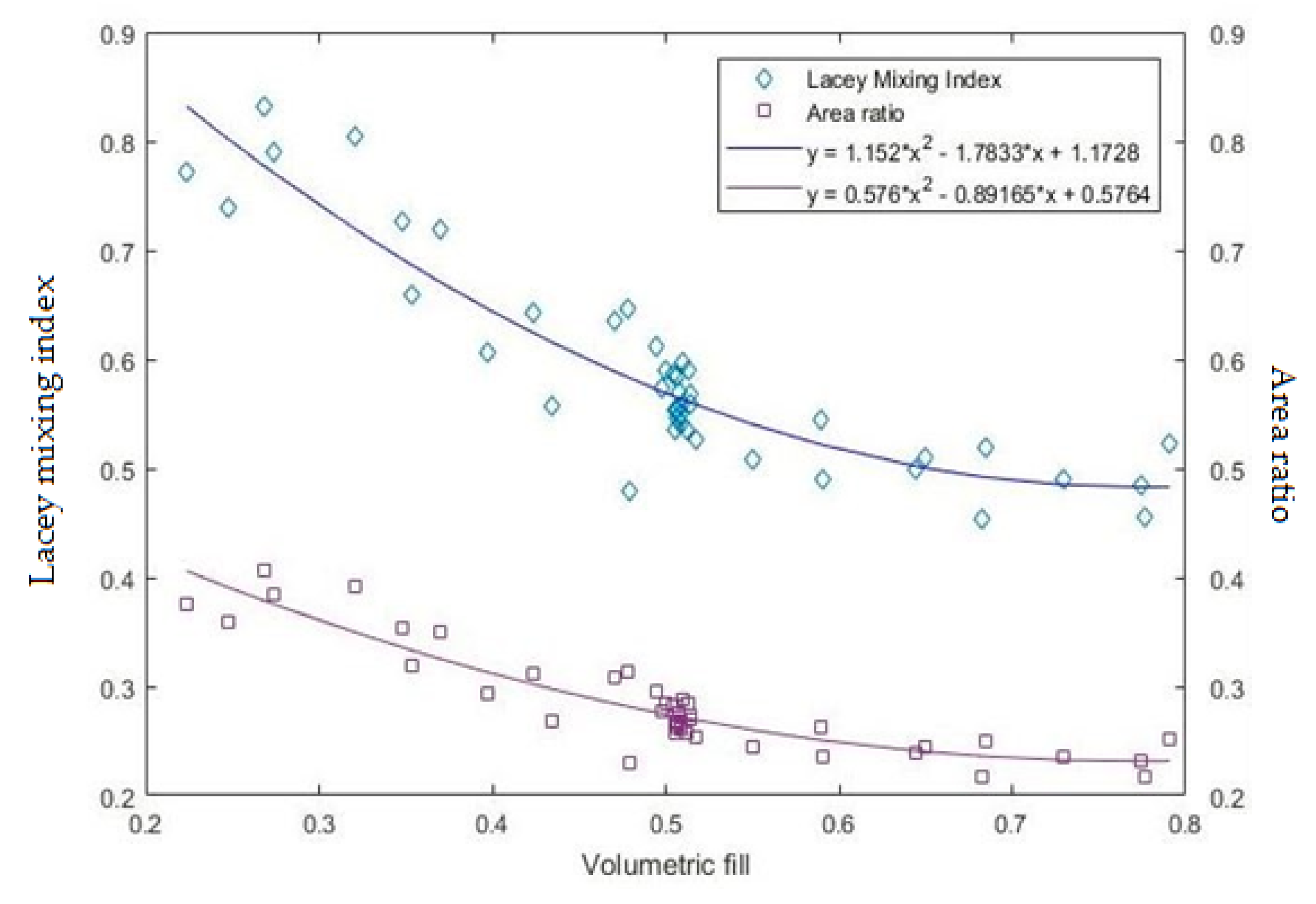
| Properties | Parameter |
|---|---|
| Fill degree | 50% |
| Drum diameter | 170 mm |
| Particle diameter | 3 mm (small), 6 mm (large) |
| Particle number | 200,000 (small particle), 25,000 (large particle) |
| Density of particles | 1430 kg/m2 |
| Coefficient of sliding friction | 0.16 |
| Coefficient of rolling friction | 0.0000722 (particle-drum), 0.0000594 (particle-particle) |
| Young’s modulus | 2.84 × 109 Pa (particle), 2.2 × 109 Pa (drum) |
| Poisson’s ratio | 0.35 (particle, drum) |
| Coefficient of restitution | 0.80 (particle-drum), 0.88 (particle-particle) |
Publisher’s Note: MDPI stays neutral with regard to jurisdictional claims in published maps and institutional affiliations. |
© 2020 by the authors. Licensee MDPI, Basel, Switzerland. This article is an open access article distributed under the terms and conditions of the Creative Commons Attribution (CC BY) license (http://creativecommons.org/licenses/by/4.0/).
Share and Cite
Widhate, P.; Zhu, H.; Zeng, Q.; Dong, K. Mixing of Particles in a Rotating Drum with Inclined Axis of Rotation. Processes 2020, 8, 1688. https://doi.org/10.3390/pr8121688
Widhate P, Zhu H, Zeng Q, Dong K. Mixing of Particles in a Rotating Drum with Inclined Axis of Rotation. Processes. 2020; 8(12):1688. https://doi.org/10.3390/pr8121688
Chicago/Turabian StyleWidhate, Parag, Haiping Zhu, Qinghua Zeng, and Kejun Dong. 2020. "Mixing of Particles in a Rotating Drum with Inclined Axis of Rotation" Processes 8, no. 12: 1688. https://doi.org/10.3390/pr8121688
APA StyleWidhate, P., Zhu, H., Zeng, Q., & Dong, K. (2020). Mixing of Particles in a Rotating Drum with Inclined Axis of Rotation. Processes, 8(12), 1688. https://doi.org/10.3390/pr8121688








